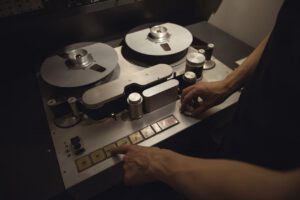Within the last few decades, the world has experienced many mind-boggling advances in technology. We must say that the revolution in the field of technology has changed the way we used to interact with the world. As a result, society is also changing at a fast pace, and the music industry is not far from this. Emerging technologies have altered the way we used to create and consume music.
British Decca is known to play an important role in the recording industry after World War II. They developed a full frequency range recording system that gained huge popularity worldwide in very little time. The frequency range of disks was greatly extended, and this new process helped record collectors perform really well in the music industry. Two more developments in the 1940s further combined the extended frequency range with leading radical changes in the recordings; they were magnetic recordings and the commercially successful long-playing record.
The evolution of recording techniques
In the year 1948, the Columbia Records demonstrated 12-inch vinyl discs with the unbreakable finish. They were reported to play music for 25 minutes per side. Note that the standard shellac disc used to revolve at 78rpm, but this 12inch disk required to be changed manually or automatically to listen to the full recording. It means the longer works used to suffer more breaks. On the other side, the 12inch LP is capable enough to revolve at 33 ½ rpm, and it can include sonata, symphony and quartet on a single side of the disc. These vinyl discs also offered quieter surface performance as compared to the shellac.
The professionals soon observed that seven vinyl discs could play at 45rpm, and they all contained music almost the same as that of the 12-inch disc that used to rotate at 78 rpm. In the year 1950, a new pattern was set where professionals started using 12-inch LPs for recording popular albums and classical works, whereas the 45s were being used to recording famous individual songs. The extended play of 45s was developed and marketed successfully. However, with time, the LPs opened up a whole new market where it started welcoming many old record collections and newcomers as well. They were all willing to experience the advantages of new technology. Many of them were even excited to repurchase their existing collections in the form of LPs.

Another major invention in the field of recording was a tape that came into light in the year 1940. With this invention, anyone with a good microphone and recorder could turn out to be a record producer. The small companies started expanding in the musical ideas that were ignored by the big giants. The list included Avant-garde, the esoteric and music of the periods reflecting before and after collection of the romantic songs of the 19th century. Chamber music and the Baroque works that were produced in the 18th century required to pay a lesser number of musicians as compared to the complete symphony orchestra. Those collections started flooding in the record stores slowly and resulted in the unprecedented Baroque revival among all music lovers.
For the owners of the deluxe tape recorders, another listening solution was available in the form of stereophonic tape recordings. Within just two years, the stereo discs started making their commercial appearance in the industry. All the major US companies, by the end of 1958, started issuing stereo discs to the audience. The Decca/London again took the opportunity to convince various serious music lovers about the incredible advantages of stereo. They spread awareness about these new discs with the release of Wagner’s Das Rheingold in the year 1959. Very soon, these professionals were able to record four complete operas in just 19 discs.
In the year 1950s, there was a rearrangement of the alliances for various record companies in the world. With time, European companies started pushing behind the American giants. In the year the 1970s, the European industries not just owned a wide range of American record industries; rather, at the same time, they had taken over the technology.
The modern recording solutions
Later, during the mid-1960s, the professionals in the recording industry launched two-reel cassettes and one-reel cassettes. They required threading tape to play them. This new invention first received great acceptance from consumers, and it turned out to be an important automobile accessory. These cassettes had their own advantages with continuous loop cartridge formats that were rewindable. Even beginners found them easier to control with better selection options. For non-selective music, it was not necessary to begin from the first song. By 1982, the sales ratio of these recorded cassettes took over the traditional LP discs.
With the advancements in technologies, a new recording technique came into the market. The music tapes became highly digital with the pulse code modulation technology. This concept was given by Denon label in Japan; however, it was soon adopted by Cleveland-based Telarc Records. Furthermore, the world adopted the new music technology with the classical releases of the compact disks that were better known as true digital discs.
In the present times, the songs can be recorded using specially designed software tools online. The process has become pretty simple, even for beginners these days. The tiny devices can store unlimited data, and it can be played easily at any time. It is even possible to record music using smartphones and offers mass accessibility online. In this era of advancements, people have started learning musical instruments via online courses. If you are interested in playing piano notes, you can also join the piano2notes platform. This tool can help you to convert piano sound into relevant notes online, and you can download a PDF version of the content instantly. The interactive features of this online platform make things pretty simple for beginners. It can be accessed easily on handsets, tablets and computers as well. If you are interested in making a career in music, it is good to start using the advanced software now.

